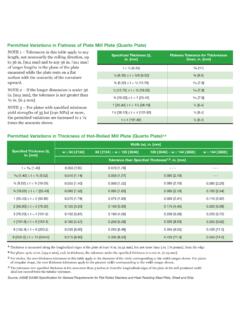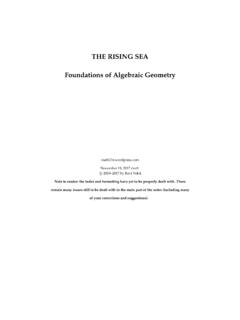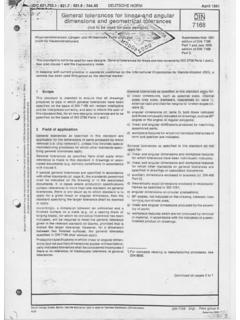Transcription of How to Measure Flatness with Optical Flats by Van Keuren
1 Provided by Productivity Quality Inc s Metrology Toolbox - 1 - How to Measure Flatness with Optical Flats by Van Keuren Introduction The easiest and best way to test the Flatness of a flat lapped or polished surface is with an Optical flat. Such surfaces are found on micrometers, measuring machines, gage blocks, snap gages, ring seals, valve seats and precision flat lapped parts. The surface must be sufficiently finished to reflect light; ordinary ground surfaces are too irregular to show light wave interference bands. However, unless the material is extremely soft or porous, a few rubs on a flat lap will smooth off the top of the grinding ridges and enable bands to be seen in monochromatic light. The Phenomenon of Interference Bands When there is an extremely thin wedge between two flat surfaces a series of interference bands or fringes appear.
2 The bands occur at right angles to the slope of the wedge. They represent intervals of approximately millionths of an inch ( nanometers) from the surface being tested to the Optical flat when a monochromatic light of millionths ( nm) wave length is used. The Van Keuren series of helium monochromatic light sources provide a highly diffused light of this wave length. Dark bands occur because light reflections from the two surfaces which form the wedge interfere with each other where the thickness of the wedge is one half or multiples of one half the wave length of the light. The parallel bands thus form at zones where the wedge thickness changes by 1/2 wave length. Between each pair of dark bands the reflections reinforce each other and produce bright bands. When viewed perpendicularly in helium light, the dark bends are located where the air wedge thickness changes by equal intervals of.
3 00001157" ( nm). Procedure For Making Flatness Tests Remove the dust from the surface of the work and the Optical flat with a camel hair brush. Burrs and nicks should be removed by using an appropriate deburring stone. Place the work under the monochromatic light. Place a clean piece of Optical tissue (or any other clean paper) over the work piece. Place the Optical flat on top of the paper; the Optical flat may be on the bottom in cases where a reflex light is used. Provided by Productivity Quality Inc s Metrology Toolbox - 2 - Hold the Optical flat steady with one hand and draw the paper out from between the work piece and the Optical flat with the other hand. If bands do not appear, repeat this procedure. This will reduce the possibility of scratching the Optical flat and the workpiece--as in scrubbing both pieces together. The bands should be viewed from a distance at least 10 times the diameter of the Optical flat and with the line of vision as nearly perpendicular to the flat as possible.
4 If the bands are straight, parallel and evenly spaced, the surface is flat. If the bands are curved or are unevenly spaced, the surface is not flat. If Bands Fail to Appear If the Bands fail to appear it may be due to one of the following reasons: Dust, burrs or nicks are still holding the Optical flat away from the surface. Do not slide the Optical flat around on the surface in an effort to make the bands appear as this may scratch the flat. Instead, try again after recleaning the surface or removing the burrs. The wedge between the surface of the work and the Optical flat may be: Too thick. Press down on the Optical flat with a uniform pressure to squeeze out the air film. Too thin. If moisture or oil is present if may cause the Optical flat to wring or adhere to the work so closely that bands cannot appear. Too angular. The flat may be making too great an angle with the work, in which case the bands will be so close together as to be nearly invisible.
5 Try putting pressure at different points around the edge of the Optical flat. Too nearly parallel. This rarely occurs. In this case however, the bands would be so far apart that they would not be distinguishable as bands. Amount of Flatness Error The amount that the bands curve, with reference to the distance between them, indicates the amount of Flatness error. In judging the amount of curvature, imagine a line drawn across the surface from one end of any band to the other end of that same band. If this line just touches the previous band the Flatness error is 1 band ( see figure 2a ). If it comes half way between the two bands the error is 1/2 band ( see figure 2b ). If the surface is out of flat two bands the line will just touch the second band, if it is out 3 bands it will just touch the third band and so on. In practice the imaginary line may be made real by aligning a piece of fine wire or thread across the face of the monochromatic lights diffusion screen with the ends of the band, or by use of a transparent straight-edge.
6 Convex or Concave? The rule for determining whether a surface is concave or convex is as follows: If the bands curve around the thin part of the wedge (contact or pressure point) the surface is convex. If they curve around the thick part of the wedge the surface is concave. Irregular Surface Where the surface to be measured is irregular, the contact method of Flatness testing is recommended. Here the flat is placed in the most intimate possible contact with the work piece; Provided by Productivity Quality Inc s Metrology Toolbox - 3 - no attempt should be made to maintain a wedge. A band pattern such as shown in figure 3 will appear. The bands are to be interpreted as contour lines on a map, the interval being millionths of an inch ( nm). Thus the total Flatness error is equal to half the band count between points of contact.
7 In the figure shown the 12 bands between high spots indicate a valley 6 bands or millionths deep. Additional Suggestions Regarding Flatness Tests 1. The bands should be viewed as nearly perpendicularly as possible. If viewed from an increasingly oblique angle the value of millionths per dark band can increase significantly; there will be fewer bands and they tend to straighten. 2. Where an observation from a distance of 10 times the diameter is impractical, a monochromatic light employing the bent beam principal such as the Van Keuren type L light is recommended. 3. Van Keuren quartz Flats distort very little with temperature changes. However, a warm flat may distort a cold surface. Therefore, all work should be allowed to come to a common temperature before being tested. 4. The number of bands which appear is not an indication of the Flatness of the surface but relates only to the steepness of the wedge.
8 The bands may be made fewer and father apart by pressing on the Optical flat until they are most conveniently spaced for evaluation. 5. A perfectly flat surface will show straight and evenly spaced bands. In this case, a test with the bands running at right angles to their original position will show curved bands and make it possible to evaluate the curvature. Effective Band Values Viewing Angle Band Value (degrees) (micro inches) 10 20 30 40 50 60 70 80 90












